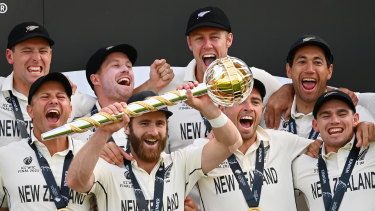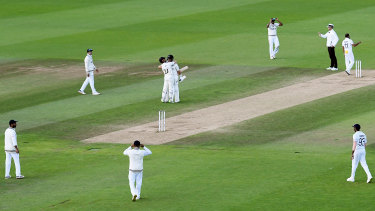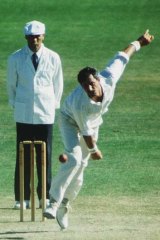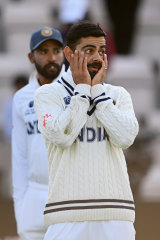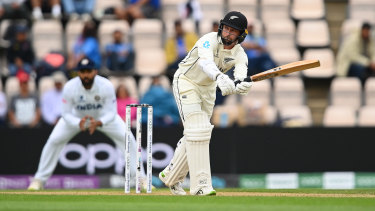Kiwis do fly, to the top of the world
It’s not that New Zealand punches above their weight. It’s that they punch above everyone’s weight.
It’s felt that way for some time now. Geopolitics, music, prime ministers, sports of all sorts – they’ve just stowed the America’s Cup away in their national locker again. The arts, landscapes, the handling of pandemics and terrorists: in all, the Kiwis are world-beating. In all, they exhibit a touch of class.
Kane Williamson holds the World Test Championship mace aloft.Credit:Getty
Now in cricket, it’s official. New Zealand are the inaugural world Test champions, and but for an obtuse provision in the World Cup rules that only came to light in the final two years ago would be title-holders in both forms. To the Black Caps, you can only dip your lid.
How mighty is their feat? Let’s go back to the weigh-in. This final was cricket’s smallest country against its biggest. It was five million people and a few bandwagoners versus 1.4 billion. Cricket New Zealand’s annual revenue of $55 million is barely more than Cricket Victoria’s, and less than Surrey County Cricket Club’s. India’s is $700 million that we know of. In India, cricket is everything. In New Zealand, it sometimes gets to no.2.
Size isn’t everything. But as sporting success increasingly is indexed to population and wealth, it’s not easily shrugged off. India’s shadow XI’s defeat of Australia in Australia last summer was ominous. Now that India were not merely flaunting their might, but using their might fully to exploit their depth, even their second XI would outmatch most others’ first XIs henceforth.
India’s team for this final featured none of the bowlers who secured that famous Gabba victory, nor Axar Patel, who subsequently took 27 wickets in three Tests against England. They had riches to spare.
Williamson and Ross Taylor celebrate the winning runs in Southampton.Credit:Getty
But the Kiwis had reserves of their own. They left out two bowlers who between them had taken 11 wickets and a batsman who had made 82 as they sealed a series victory against England at Edgbaston a couple of weeks previously. They were place-holders.
India might be able to pick two or three world-class XIs, and the Kiwis might have only one, but only one can play at a time. On the field at Southampton, it was 11 versus 11. Weight became abstract, its effect figurative at best.
This leads to the heart of the matter. In cricket at least, because the Kiwis never have weight to throw around, they’re neither impressed nor bothered by those who do. A team who used to play in tan and whose nickname is a spin-off from the outfit who truly rules the country’s heart could never have afforded pretensions.
Sir Richard Hadlee.Credit:AP
Their crowds sometimes are boisterous – as if ours are not – but it’s hard to think of an objectionable Kiwi cricketer. Even John Bracewell in his time looked more like he was playing an abrasive character than playing as one.
Sometimes these nice guys ran as high as second. In the Hadlee-Crowe era, they gave the then tyrannical West Indies headaches as others could not.
But it was Brendon McCullum – Kane Williamson’s St John the Baptist – who formalised the idea that the Black Caps would play with a kind of humble, yet earthy grace that he felt truly represented his nation. By humble, I mean respectful rather than deferential. McCullum always said they were not good enough to rub other people’s noses in it.
In 2015, Australian wicketkeeper Brad Haddin sneered at New Zealand for being too nice, an attitude that revealed much about both sides. He had the last curl of the lip then.
A downcast Virat Kohli on the final day.Credit:Getty
But look now. The Kiwis have made the final four at the last four World Cups and played in the last two finals, and the now Test championship is on their mantelpiece. It was Richard Hadlee, no less, who said on Thursday that they deserved to be called the best team in their country’s cricket history.
Naturally, now that none of the big dogs have won it, the format of the Test championship has been called into question. Certainly, it was flawed. An inequitable points system was compounded by COVID cancellations before a rain-protracted final. It was a first attempt, necessarily with rough edges. Let the sanding start.
Some in Australia carp that the Kiwis have never won here, as if Australia don’t have blind spots and Bermuda Triangles of their own. As much as it matters, the Kiwis did beat India in the qualifying series. They also beat England home and away during that time, in series that did not count towards the championship. That is, even the Kiwis are now beating England for fun.
Indian captain Virat Kohli, while not ungracious, said the final should be a series to be a true test. This overlooks two things, that no country is going to agree to a window big enough, and that in many – most – sports, round-robin play is followed by knockout finals. In other sports, it is all about the day. India had six of them.
This final was truly a test. In difficult conditions, the Kiwis got the detail right more often, which is how you win at Test cricket. The scoring throughout was low and slow. It won’t have won the Test format new friends, but cricket has other forms for that.
New Zealand revelation Devon Conway in action.Credit:Getty
It re-endeared the game to its old and still plentiful friends, an obligation many sports administrators neglect. The pace was slow not because the cricket was so bad, but because it was so good. The bowling was sublime. The batting was resolute. The highest score was 54, but several innings were each worth 154.
If you don’t understand that, you probably haven’t read this far into the story anyway. India and New Zealand stared and stared and stared, and then India blinked.
And so it is that India rule and run world cricket, but New Zealand reign over it.
Sports news, results and expert commentary. Sign up for our Sport newsletter.
Most Viewed in Sport
From our partners
Source: Read Full Article

